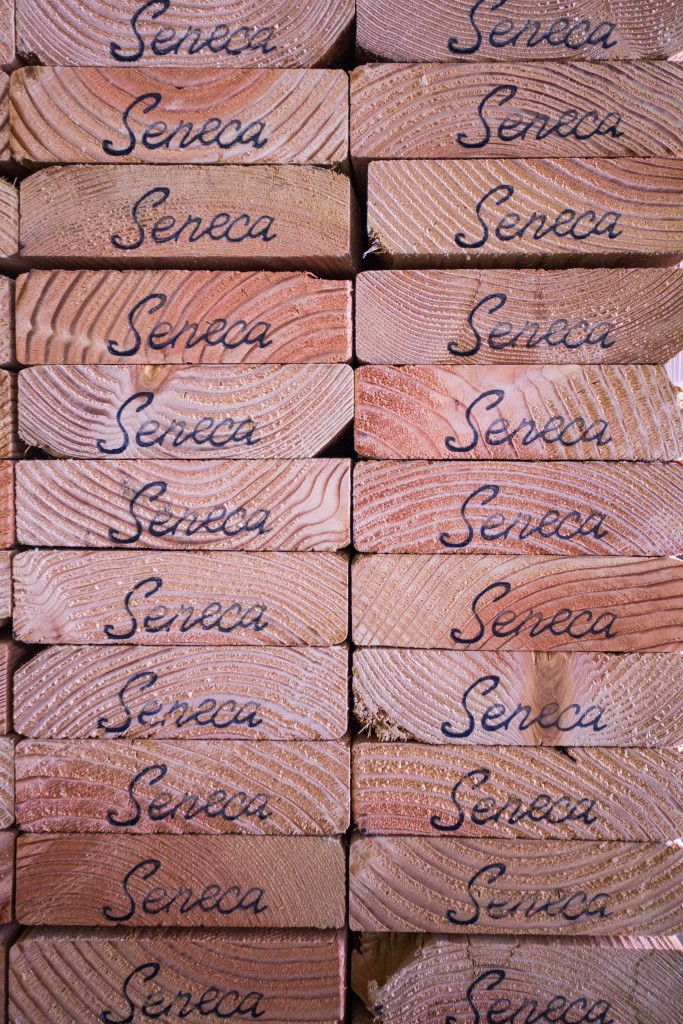So you think you know a sawmill? Men dressed in overalls on either side of a big log working a two sided saw back and forth, logs rumbling down rickety tracks, burly guys running lengths of board through a circular saw listening for the sound of the lunch whistle?
Not anymore.
The basic elements of a sawmill are still the same: logs go in on one side and lumber comes out on the other. That’s pretty much where the similarities end, though. Today’s sawmill is nothing like sawmills of settlement times or even just a decade ago. Modern sawmills are highly mechanized, highly technical, and highly efficient. Lasers guide logs on tracks that whip by at high speed, scanners determine how to customize and optimize cuts on individual logs, high speed digital cameras and sensors increase precision, and metal detectors uncover rogue saw-destroying nails. It’s like one big computerized video game, and the name of the game is efficiency.
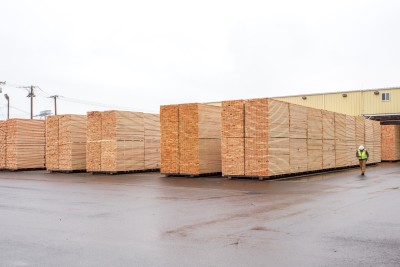
Stacks of lumber wait their turn in the kiln at Seneca’s Eugene sawmill.
Seneca’s sawmill in Eugene is a prime example of technological advancement and innovation in the lumber industry. When Aaron Jones founded Seneca Sawmill Company in 1954, it was his insistent commitment to maximizing efficiency that drove the company to secure more than 20 patents on mechanical modernization. Seneca will soon complete a $60 million expansion investment to their sawmill in Eugene that will enable them to further increase efficiency and adaptability with the addition of two new, larger dry kilns and a collection of advanced instruments that would impress most engineers.
The primary driver behind Seneca’s expansion is a change in the marketplace. Demand in the lumber market has shifted to a greater reliance on dry wood over green wood, primarily as building code regulations have been modified to reduce mildew and mold growth. What that means for companies like Seneca is that they’re selling more wood that’s been dried to contain less than 18 percent moisture. That’s done by using kilns to heat the finished lumber for 35 to 60 hours at 180 degrees. Three of Seneca’s five kilns have been added in the last two years as the demand for dry lumber has increased. The new addition allows Seneca to dry approximately 60 percent of its overall lumber production at the Eugene facilities.
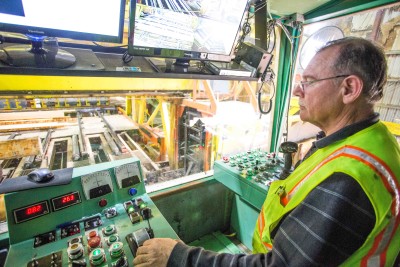
Dave Alford works from the control room at Seneca’s mill. Dave has worked for Seneca for more than 30 years as a headrig operator.
The expansion also provides an opportunity for Seneca to further develop and enhance technology within the mill to increase efficiency. After logs are sorted by size and run through the debarker, each log is scanned by what’s called the merchandizer. The goal of the merchandizer is to evaluate the best use for each log based on its particular qualities. It takes into account slight variances in grain, bend, and knots, and references current sales prices to determine how to get the most value out of each individual log. By holding the log stationary and running the scanner over the log (as opposed to running the log through a stationary scanner) Seneca is able to get a slightly more accurate scan and subsequently slightly better optimization. Multiply that by thousands of logs scanned each day, and the end result is a significant reduction in waste. By cutting what the market demands that day, Seneca increases efficiency and is able to provide on-demand products.
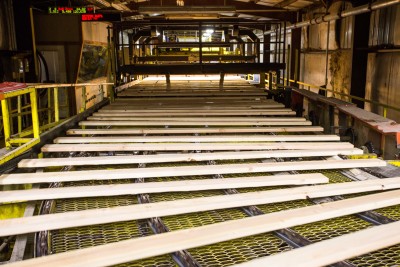
Lumber heads in to the scanner at Seneca’s Eugene mill.
Seneca also utilizes laser and sensor technology to sort the lumber by grade to ensure quality and meet design expectations. By combining color vision technology with high density geometric scanning, mill operators get a precise three dimensional look at the product and make decisions on grade and ways to trim the product to increase value. The lumber is then stamped with a grade and scanned to guarantee no piece is missed.
An increase in mechanization has also led to an increase in higher wage jobs at the mill. It also means fewer workers are physically moving, sorting, and marking lumber which dramatically increases safety for the mill’s workers. Seneca’s Eugene mill employs a talented staff of controller and programmers along with a skilled group of millwrights and electricians all dedicated to maintaining state-of-the-art equipment and technology. In the filing room, seasoned saw filers work on repairing and keeping the many saw blades sharp. Every blade gets sharpened twice a day and some are coated with a stellite tip, a hardened alloy designed to keep the saw tooth sharper, longer.
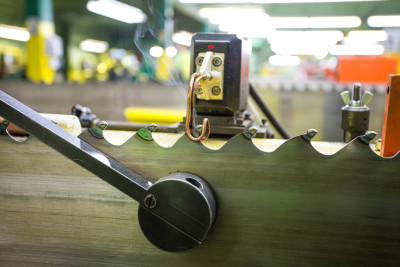
A hardened alloy called stellite is applied to the saw blade to keep the saw tooth sharper, longer.
Sharp blades are important when efficiency is the name of the game, and running the logs through a metal detector before they enter the mill also helps protect those blades. A nail buried deep in a log can wreak havoc on a system that is driven by speed, efficiency, and optimization.
As further proof that not a scrap of the tree is wasted, the leftover sawdust is blown out of the mill at the end of each shift and used to power, in part, the mill’s on-site biomass energy facility. The heat generated by burning sawdust, bark and shavings in the biomass facility is used to power the kilns that dry the lumber, bringing the whole system into an efficient cycle of optimization.
Never settling for the status quo, Seneca continues to chart a course of automation, optimization and efficiency, all necessary attributes to remain on the cutting edge of wood products innovation.
